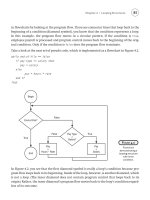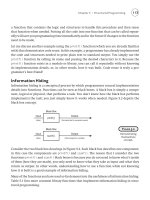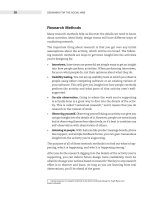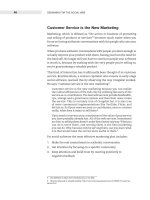designing for the social webj PHẦN 7 pot
Bạn đang xem bản rút gọn của tài liệu. Xem và tải ngay bản đầy đủ của tài liệu tại đây (7.73 MB, 20 trang )
ptg
108 DESIGNING FOR THE SOCIAL WEB
According to the “rule” of reciprocity, when this happens, the person
feels obligated in some small way to contribute a restaurant review. They
realize that others will then in turn benefit from their contribution, just
as they have benefited from others.
Yelp does a good job of leveraging reciprocit y on their profile pages.
Before you have written a profile, they gently nudge you to do so by sug-
gesting that “It’s your turn to be the critic.” This copy does two things:
1) it suggests that in all fairness (reciprocity-wise) it’s your turn to write
reviews, and 2) it empowers you to be a food critic, which is a great way
to motivate someone. Who doesn’t want to be a food critic?
Figure 5.8 Yelp does a good job of leveraging reciprocity by hinting that “It’s your turn
to be the critic.”
Sometimes designing for reciprocity simply means giving the oppor-
tunity to respond or act in kind. When someone does something like
comment on a blog or add as a friend, simply notify the recipient and
provide an option to do the same.
LinkedIn really knows how to leverage reciprocity with their “recommen-
dations” feature. When someone writes a recommendation for someone
else, there is an urge to return the favor. Browsing the site makes this
abundantly clear — many of the recommendations are indeed recipro-
cated. To elicit this action, LinkedIn can simply give someone who has
received a recommendation the opportunity to respond in kind.
ptg
CHAPTER 5 DESIGN FOR ONGOING PARTICIPATION 109
Figure 5.9 LinkedIn’s recommendations feature powerfully leverages reciprocity to
drive participation.
Allow for Reputation
A person’s reputation is the set of beliefs or opinions that others hold
about them. We each have a reputation, even if it is a small one. While
we can cultivate it, it ultimately has to come from other people. The
power of reputation is that it is unbiased, it is the opinion of others.
When reputation works well, people can judge others and their possible
interactions accurately. On a social web site, this might mean they decide
to go through with a business transaction or take a recommendation
about which movie to watch. When reputation doesn’t work, a person
can’t get an accurate impression of another person.
Designing for reputation is about deciding (or discovering) what signals
make for a positive reputation within the culture of the community who
uses your software. For example, let’s imagine you’re building a social
ptg
110 DESIGNING FOR THE SOCIAL WEB
web application for chefs. Even in two such closely related professions as
head chef and prep chef, reputation might be based on different criteria.
6
It is up to you, the designer, to figure out what these criteria are. Head
chefs might gain reputation because of the unique ways they can combine
flavors or redefine classic dishes. Prep chefs, on the other hand, might
gain reputation by how quickly and precisely they can cut food.
The review site Yelp.com has powerful reputation features:
.
Number of friends. In many social web apps, this is an implicit
indicator of reputation
.
Number of reviews written. The more the person performs the
primary activity on the site, the better their reputation is
. Ratings of reviews written. How people have judged the reviews
you’ve written: were they useful, funny, or cool?
. Number and quality of comments from other members. Another
generic feature seen on many social apps
. Number of Fans. A fan is someone who follows your reviews—this
is one of the highest compliments one can pay on Yelp
. Number and quality of compliments from other members.
This is more explicit than comments or friends in determining
reputation
. Number of Firsts. Firsts in Yelp are the first reviews of a business.
It is a coveted achievement to be the first to review a restaurant on
the service
. Member Since. Reputation is based in part on how long you’ve been
a member of Yelp
. Elite Squad Member. Members of the Elite Squad have a very posi-
tive reputation within the community
Notice that some of the reputation features on Yelp are found on other
social web apps (Friends, Fans) while some are specific to the domain
(Reviews, Firsts, Elite Squad).
6 For an interesting story on the reputations of chefs, check out:
article/0,9171,428007,00.html
ptg
CHAPTER 5 DESIGN FOR ONGOING PARTICIPATION 111
Figure 5.10 Yelp.com is full of both implicit and explicit reputation-based features:
number of Friends, Fans, Compliments, number of Firsts, review feedback, and the Elite
Squad all signal reputation within the world of Yelp.
It makes sense to do this, because not everyone will be good at garnering
reputation in all possible ways. Some people might not have that many
friends on the service, for example, but they still could contribute very
valuable reviews that get rated highly. Yelp does a great job allowing
multiple ways to achieve a positive reputation. This enables more people
to gain a reputation for the things they do best.
When Reputation is Crucial to Cooperation
On Yelp, reputation is a nice-to-have. It is not crucial for every transac-
tion, as it is possible to read and write reviews without knowing the
reviewer’s standing in the Yelp community.
In some cases, like on the auction site eBay, reputation is crucial for
cooperation. Buyers and sellers never meet face-to-face, as they do
in most purchasing situations. If buyers couldn’t effectively judge the
reputation of the person they’re giving money to, then the transaction
wouldn’t happen.
ptg
112 DESIGNING FOR THE SOCIAL WEB
eBay works because of a sophisticated reputation system built out of
several design elements refined over time. The system is based on what
they call a “Feedback Score.” When a transaction occurs on eBay, the
buyer and seller each leave feedback about the experience. Feedback
consists of a rating (positive, negative, or neutral), and a short comment.
These ratings are used to determine feedback scores.
Feedback scores are what other people in the system see while they are
bidding, so they are a crucial indicator of reputation. If your feedback
score is high, then others will trust you and be more likely to do busi-
ness with you. If your feedback score is low, they’re more likely to pass
and do business with someone else.
The process goes like this:
. After a transaction has occurred, sellers and buyers each rate the
transaction by leaving feedback
7
. For every positive feedback rating someone receives, their feedback
score rises by one point
.
For every negative feedback rating someone receives, their feedback
score lowers by one point
.
The buyer’s and seller’s “feedback profile” is updated to show
their cumulative feedback score as well as each individual feed-
back rating
The “Feedback Profile” is the primary screen showing reputation on
eBay. It contains a person’s entire feedback history, both as a buyer and
a seller. It is a sophisticated document.
Since so much money is changing hands on eBay, members pay tremen-
dous attention to what goes on here. Stories of fraud and gaming the
system crop up now and then, but eBay has consistently provided enough
of a reputation system to keep it all working. (Of course, it doesn’t hurt
that they boost this with a visible Fraud Investigation Team).
7 Interestingly, in February 2008 eBay decided to remove the ability for sellers to give feedback to buyers
ptg
CHAPTER 5 DESIGN FOR ONGOING PARTICIPATION 113
Figure 5.11 eBay’s Feedback Profi le is a sophisticated document that shows feedback
ratings over time. It is a snapshot of reputation within the eBay system.
Some ways that eBay protects your feedback score:
. Each feedback rating raises or lowers your total feedback score by
one point only—so one bad day or one good day doesn’t mean much,
what matters is your reputation over the long term
.
Each member can only affect someone’s feedback score by one point—
one person cannot have an undue effect on another’s score
. The comments associated with feedback allow people to describe
any outstanding circumstances
.
eBay shows recent feedback more prominently than older feedback,
so what you have done lately is more important
. eBay has a very clear section describing in minute detail how repu-
tation works on the site
.
eBay has sophisticated ways to monitor whether people are pushing
up their own feedback scores by creating multiple accounts
The sophistication of this design can be seen in figure 5.12. It is not a system
you can build overnight. eBay has slowly refined it over several years.
ptg
114 DESIGNING FOR THE SOCIAL WEB
Figure 5.12 eBay has a sophisticated reputation system that is crucial to the
site’s success.
Promote a Sense of Efficacy
While reputation is what people say about you, efficacy is your own
sense that you’re being productive. In many cases these two things go
hand in hand. The more your reputation grows, the more productive
you feel.
A sense of efficacy (pronounced EFF-icka-see) is the feeling you get
when you’re doing good work, and having an effect on the world around
you. Efficacy is an important factor in some people’s decision to par-
ticipate: sometimes they’ll only participate if they feel they can make
a difference.
Interviews that I’ve had with people using social software play this out.
In one project I interviewed several people who were writing reviews of
restaurants. I asked them what motivated them to participate. Though
nobody ever said the word efficacy, it was clear from their comments
that this was so. Here are a few quotes from that research:
I just want to help others in my situation.
If there’s a restaurant that hasn’t been reviewed and I think people should
know about it, I’ll add one.
I don’t want people wasting their money on a bad experience (so I write good
reviews to prevent that).
Likelihood
of meeting
in future
Ability to
identify
each other
Ability to
identify
each other
Record of
past behavior
ptg
CHAPTER 5 DESIGN FOR ONGOING PARTICIPATION 115
Designing for efficacy means focusing on elements that provide feedback
to people about how valuable their contribution was.
We’ve already mentioned the elements of the Yelp profile that help drive
reputation. One in particular—compliments—helps to give a strong
sense of efficacy as well.
Figure 5.13 Compliments on Yelp.com
are aimed at giving people a sense of
effi cacy—that they’re having a positive
effect on their environment.
Getting Two People to Cooperate
Robert Axelrod, whose article “The Evolution of Cooperation” (later a book) has become one of the
most cited articles in the history of Science magazine, identifi es three requirements for the possibil-
ity of cooperation.
8
Interestingly, Axelrod wasn’t using the web for his research, as it didn’t exist. He
was observing people in the fl esh. His observations, however, apply very well on sites like eBay.com,
where cooperation is critical.
1. Probability of Meeting in the Future. If there is no or low probability of meeting in the future,
then there is little incentive to act nicely. Either person can easily act selfi shly and get away
with it because they won’t have to deal with seeing the other person again. Online, making
sure two people meet in the future can be diffi cult to achieve, usually meaning that both par-
ties will continue using the service (as they never actually see each other in the fl esh).
On eBay, the place where two people meet is at the end of the auction, when the seller ships
an item to the buyer to complete the actual transaction.
2. Ability to Identify Each Other. As the famous New Yorker cartoon said, “On the Internet,
nobody knows you’re a dog.” On eBay, surprisingly, you never really know who you’re deal-
ing with. But their reputation system is so sophisticated that you don’t need to. All you need
to know is someone’s reputation within the system. You don’t need to know their real name,
just their eBay handle. The proof is in the pudding: a simple handle is all that is necessary to
transact billions of dollars
3. Record of Past Behavior. The best way to predict the future is to look at the past. We all
have some sense of the truth of this. eBay is fantastic at showing a history of past behavior
on both the item page as well as the Feedback Profi le.
8 “The Evolution of Cooperation”: />ptg
116 DESIGNING FOR THE SOCIAL WEB
Provide a Sense of Control
Providing a sense of control is crucial in the design of social web sites.
The social network site Facebook learned this lesson the hard way in
early September 2006. Their experience is a casebook study.
At that time Facebook released a new feature called the news feed and
a similar feature, the mini feed. Like all social web apps, Facebook was
trying to increase the social interaction of the site.
The news feed was meant to show participants more information about
what was going on around them. It was located on the home page (when
people are logged in) and showed people all the latest activity of their
friends. It showed when someone added a friend, when someone joined
a group, and when someone wrote a message on another’s profile. This
information was not new. Anybody could find it out by visiting each of
their friends’ profiles in turn. The primary innovation of the news feed
was that it aggregated formerly isolated information in one, easy-to-
read screen.
Figure 5.14 Facebook’s news feed was meant to simply display more of what was going
on. The people who fi rst saw it, however, didn’t like that.
Within twenty-four hours of release, however, the Facebook commu-
nity revolted loudly against the new features. They claimed it was a
violation of their privacy. Within hours, a new group was created on
ptg
CHAPTER 5 DESIGN FOR ONGOING PARTICIPATION 117
Facebook to denounce this feature. It was called “Students Against the
Facebook News Feed” (Facebook hadn’t yet opened up the service to all).
The group quickly gained steam, gathering hundreds of thousands of
members within just days of its formation. It was clear that Facebook
had to do something.
Figure 5.15 The protest group “Students Against Facebook News Feed” was created
and grew within the very framework it was protesting.
Mark Zuckerberg, the twenty-two-year-old CEO of Facebook, had a
response for them. He wrote a blog post telling everyone to “calm down,”
pointing out that the feature didn’t expose anything that wasn’t already
on the site. He said that it was Facebook’s highest priority to protect its
members, and pointed out that none of the information on the news
feed features was actually new. The only difference was that now all
that information had been aggregated into one place.
Figure 5.16 Mark Zuckerberg’s fi rst attempt at calming down the masses
during the news feed blowup. Telling people to “calm down” while not
addressing their concerns is not a good idea…
ptg
118 DESIGNING FOR THE SOCIAL WEB
If you read Zuckerberg’s post closely, you’ll notice that he doesn’t really
acknowledge the issue at hand: the feeling that privacy had been invaded.
What he does instead is try to rationalize the feature by pointing out
that it doesn’t show any more information than people could have
found themselves.
Of course, that wasn’t good enough. People were still angry. The Facebook
community didn’t appreciate Zuckerberg telling them what they should
or should not get excited about. Some compared the news feed to putting
up a video camera outside your living room window. After all, anybody
could see in if they happened to be walking by. This would simply be
an aggregated view for everyone else. No new information, just like the
news feed. So the protest group grew in force. Instead of quieting the
problem, Zuckerberg’s comments had made the situation worse.
Facebook tried again, and their next attempt to quell the uprising
worked. First, Zuckerberg finally apologized. Second, Facebook added
privacy options for the news feed that allowed people to turn off the
features. Within a couple days of the apology and new privacy settings,
the uproar had blown over.
The Real Issue: a Sense of Control
The afterstory might be as telling as the uprising. Even though hundreds
of thousands of people joined the protest group, only a small percent-
age of Facebook members ever changed their privacy settings! Most
people leave the default (no privacy) setting intact. So even though they
protested the new feature on the basis of a lack of privacy, it was really
control they sought.
As noted security expert Bruce Schneier explained, privacy is more
about control than it is about secrecy. Once Facebook put in controls
that allowed people to choose what information was published, they
were satisfied:
Welcome to the complicated and confusing world of privacy in the
information age. Facebook didn’t think there would be any problem;
all it did was take available data and aggregate it in a novel way for
what it perceived was its customers’ benefit. Facebook members
instinctively understood that making this information easier to
display was an enormous difference, and that privacy is more about
control than about secrecy.
9
9 />ptg
CHAPTER 5 DESIGN FOR ONGOING PARTICIPATION 119
Confer Ownership
The mere name MySpace confers a sense of ownership. It has its audi-
ence thinking: this is my online space. I own it. I can do with it what
I want. YouTube takes the other tack, using the word “you” instead of
“me,” but the result is the same. It’s yours, you own it, do with it what
you want.
Both sites confer ownership to their audience. They make it clear that
this space is their property. Using words like “my” or “your” may seem
like little more than rhetoric, but there’s real psychology at play here.
These sites are leveraging what’s called the Endowment Effect.
10
The
Endowment Effect is the tendency of people to value things more once
a sense of ownership has been established.
It’s not just about site names, however. In design, ownership can be
conveyed best in copywriting and labeling. By using words such as “you”
and “my” where appropriate, designers can imply ownership and give
people the feeling that their content is something worth holding onto.
Conferring ownership has several benefits:
. Leverages the Endowment Effect to make content seem more
valuable
.
Conveys a sense of responsibility for the content if others are around
(people will be more likely to take care of it)
. Empowers people by suggesting that they are in control of their
content
. Makes the site feel more familiar and friendly
One of the oldest and best examples of this is Amazon. They go further
than most apps, even conferring ownership of an entire portion of the
site to each person who has an account. When I go to Amazon, there
is a section called “Joshua’s Amazon.com.” Not only did they give me
ownership of content, I even have my own version of Amazon.com!
Figure 5.17 Amazon.com confers ownership in a big way. In this sliver of screen alone,
there are seven references to things that are mine.
10 />ptg
120 DESIGNING FOR THE SOCIAL WEB
Flickr.com also does a great job of conferring ownership. They sprinkle
the site with ownership words, making it absolutely clear whose content
we’re dealing with.
In Flickr’s navigation scheme, for example, one of the tabs is labeled
“You.” When you click on the dropdown for this tab, you get fourteen
options, eleven of which refer to content that is “yours.” Flickr’s labels
make it very clear who owns what on the site.
Don’t take conveying ownership too far, however. The designers at
Motortopia, a motor-enthusiast site, designed a panel on their profile
pages that is jarring because of an over-emphasis on ownership. Instead
of focusing on the person who is using the app, they display over and
over the username of the person whose profile one is looking at. In this
case, it would be safer to go without the repeated username. In general,
other people’s ownership is implicit on a profile page and doesn’t need
to be emphasized. Instead, emphasize ownership to the person using
the app.
Figure 5.19 Motortopia.com took ownership a bit too far, making
each option hard to scan. In this case, it would be much easier to
read without the username.
Show Desired Behavior
If you peruse the profiles found on many of the pages of Yelp, you might
come away thinking that you’ve been transported to Lake Wobegon
where “all the children are above average.”
That’s because Yelp takes pains to promote certain profiles whose
owners behave as model citizens. They tend to have huge numbers of
friends, lots of reviews, and other gaudy numbers that represent success
on the site. It’s clear that the designers at Yelp want to promote desired
behavior in the hopes that others would see and emulate it.
Figure 5.18 The photo-
sharing site Flickr really
knows how to confer
ownership to its members.
Their navigation is all
about YOU.
ptg
CHAPTER 5 DESIGN FOR ONGOING PARTICIPATION 121
For example, on its homepage Yelp places a “review of the day.” Invariably,
the review is written by a reputable member of Yelp who has amazing
profile numbers. When newcomers see this review, they learn what
behavior is appreciated. They learn by observing what happens.
Figure 5.20 Yelp.com places “reviews of the day” in prominent locations to show
desired behavior to newcomers. They tend to have impressive numbers that show
successful behavior to others.
Endowment Effect
The Endowment Effect is the idea that people value something more when they feel a sense of
ownership. We all know what this is like. From the moment we fi rst compare our bicycles with our
friends’ bikes, there’s something special about ours simply because it is ours.
The classic study of the endowment effect involves economics. To test for the presence of the ef-
fect, researchers usually test whether or not people will insist upon selling an item for more than
they can buy it for. This would show that they value it more because they own it.
This quickly gets murky, however, because there are many shades of “ownership.” Technically,
we own something the moment we pay money for it. But for many things, this notion of owner-
ship is weak. Certainly, we give items meaning based on our history with them. We value a gift
from a loved one much more than the exact same item received in some other way.
From a less economic point of view, however, we have a very common way to describe the
Endowment Effect. When we say that an item has “sentimental value,” suggesting that its value
goes beyond its inherent value as an object, we are pointing to the Endowment Effect.
On the web, we’re often talking not just about items we own, but items we create. This is im-
portant because items that we create (pictures, blog posts, bookmarks, comments, etc.) tend to
have much more meaning than items we did not create. Everyone likes to feel ownership in and
be proud of their creations.
ptg
122 DESIGNING FOR THE SOCIAL WEB
Attachment to a Group
Attachment to a group is one of the more straightforward reasons why
people participate online. You can find a lot of people interested in the
same weird things you are!
Yahoo, Google, and MSN Groups are applications dedicated to supporting
groups. They are massive. Each service has millions of members who
create groups on nearly all topics known to mankind, from cricket fans
to stupid joke buffs to alternative medicine consumers.
Figure 5.21 The number of groups within the computers category is astounding. Pretty
much every topic imaginable is covered.
Of course, you don’t need to use “group” software to be part of a group
online. Groups are really the center of most social software.
Fun Features
Last but not least, a major reason why people participate is simply
because it’s fun. Web applications run the gamut of fun, from cold,
process-based apps that are no fun at all, to productivity-sucking games
that are nothing but fun.
ptg
CHAPTER 5 DESIGN FOR ONGOING PARTICIPATION 123
Fun isn’t just fun, though. Creating fun web apps can be a great way to get
people engaged, even in serious activities. The site Social Impact Games
11
is a compendium of such games, chronicling apps that exist to have fun
as well as teach us something along the way.
The folks at Twitter know how to add fun to their social web application.
For Valentine’s Day 2008, they added functionality that let someone
declare their love for someone else.
Figure 5.22 The folks at Twitter created a tiny little addition to the
app that made Valentine’s Day a little more fun for everyone.
Figure 5.23 What Twitter output when you typed in the code above.
In Search of Passion
Once you have a number of people who use your web site on an ongoing
basis, your hope is to get at least a few of them to become passionate
users. It’s these people who then support new people interested in your
service and are always telling everyone how wonderful you are.
11 />ptg
124 DESIGNING FOR THE SOCIAL WEB
Figure 5.24 The hurdle
of emotional attachment
(passionate use) won’t be
cleared by everybody. But tilt
the odds in your favor by being
passionate in order to receive
passion in return.
Truthfully, if there were an easy way to create emotional attachment,
there would be many more passionate users out there. Kathy Sierra,
who writes the Creating Passionate Users blog,
12
says a big part this
last hurdle is about helping your users learn. If you can help people
learn about their world (and assuming your software makes sense in
that world) then you empower them to see themselves in a better light.
They literally feel better about themselves. Kathy calls this moment of
self-empowerment “users kicking ass”.
Viewed in this way, the major hurdle to passionate use is not only
reached after a person is using your software regularly, but can be
seeded much earlier, when they are first learning about your software.
As I mentioned in Chapter 3, an authentic conversation is the start to
any strong relationship. In short, passion works both ways. You need
to exude it in order to receive it in return.
Conclusion
The design of social web applications rests on our ability to identify
and support the basic motivations of the people who use our software.
Once we identify what those motivations are, we can fine-tune our
design appropriately.
The basic motivations outlined in this chapter—identity, uniqueness,
reciprocity, reputation, efficacy, control, ownership, attachment to
a group, and fun—are all possible reasons for someone to use your
software. Your web site will most likely draw upon a unique mixture
of these motivations. In some cases, your users will even become pas-
sionate about your software. You can make this possible by helping
people learn and by being passionate yourself.
Finally, these basic motivations for online participation apply to a wide
variety of web sites. In the next chapter we’ll look more closely at a
particularly interesting type of web site: those that harness collective
intelligence.
12
Regular use Passionate use
Emotional
attachment
ptg
125
6
Design for Collective
Intelligence
The wonderful world of
complex, adaptive systems
When working in social, economic, environmental systems,
we often assume one action has one result that it will happen
relatively soon.
But experience has shown us that we are managing tightly
interconnected, delayed, complex systems where one action has
multiple, often counterintuitive, results. Delays and perverse
effects are common.
Our brains just don’t capture these system features well.”
— Sustainability Institute
1
1 Sustainability Institute:
“
ptg
126 DESIGNING FOR THE SOCIAL WEB
It’s not often you hear of a web site dropping a feature. In a world of
rampant feature creep, we hear press releases and blog reports daily
about our favorite services adding new, better features. It’s incredibly
rare that a fully-released feature is taken out of a web site.
Yet dropping a feature is exactly what the designers at Dig g.com did on
February 1, 2007. Digg is a social news site that collects stories submitted
by users and provides a voting mechanism by which people can digg
those stories. When stories enter the Digg system, they’re displayed on
the Upcoming page. The more diggs a story gets (the most dugg stories),
the more prominent its placement on the site. This is called getting
promoted. If a story gets enough diggs, it is promoted to the venerable
Digg home page, where tens of thousands of visitors will see it over the
course of a few hours. If a story gets submitted but fails to garner enough
diggs, it simply disappears from the Digg site after a short time.
The feature the designers at Digg dropped was the Top Diggers page,
which displayed the people (diggers) who were most successful at get-
ting stories promoted to the home page.
Figure 6.1 Top Diggers page on digg.com. In February 2007, Digg actually dropped this
page from the site, citing concerns over manipulating the popular stories on the site.
Digg CEO Kevin Rose explains the reason for dropping the feature:
(We’ve noticed) a disappointing trend… over the past several
months. Some of our top users… are being blamed by some outlets
as leading efforts to manipulate Digg. These users have been listed
on the “Top Diggers” area of the site that was created in the early
days of Digg The list served a great purpose of recognizing those
who were working hard to make Digg a great site, as well as a way
for new users to discover new content. Now… we believe there are
better ways to discover new friends based on your interests and
what you’re digging.
ptg
CHAPTER 6 DESIGN FOR COLLECTIVE INTELLIGENCE 127
So what does this all mean? After considerable internal debate and
discussion with many of those who make up the Top Digger list,
we’ve decided to remove the list beginning tomorrow.
2
As Rose hints, the situation that led to the decision to remove the Top
Diggers feature from Digg wasn’t a single incident, but arose from the
complex interaction of many people over time. Digg made a social
design decision that affected not only the people on the list and those
who voiced concerns, but everyone on the Digg site.
This issue is unique to social software: sometimes it makes sense to
focus design decisions on the good of the group at the expense of the
individual.
When Digg took away the Top Diggers feature, they made the system
less valuable for the Top Diggers but more valuable for the larger Digg
community over the long term.
Complex Adaptive Systems
Digg, like many other interesting things in life—ant colonies, immune
systems, ecosystems, politics, economics, science—is what is known
in academic fields as a complex system. A complex system is “a system
composed of interconnected parts that as a whole exhibit one or more
properties (behavior among the possible properties) not obvious from
the properties of the individual parts.”
3
The interactions of the Top
Diggers, and the reactions of the others on the site, are an example of
this complexity.
In addition to being complex, some complex systems are also adaptive,
meaning that they have the capacity to change over time. This trait is very
important to their survival. Digg adapts is through the digging feature.
If enough people digg new stories, the system adapts to give them more
time on the site. If people don’t digg them enough, the system replaces
them with newer ones, sometimes in as little as one hour.
4
Additionally, the needs of these systems change over time. While the
Top Diggers feature was good for a small, growing Digg, it was not so
good for a larger, established Digg community. Thus these systems are,
for the designers tasked with keeping them healthy, a moving target.
2 />3 />4 Francis Wu and Bernardo Huberman study this stuff:
dn11702-diggcom-reveals-news-stories-fade-after-1-hour.html









